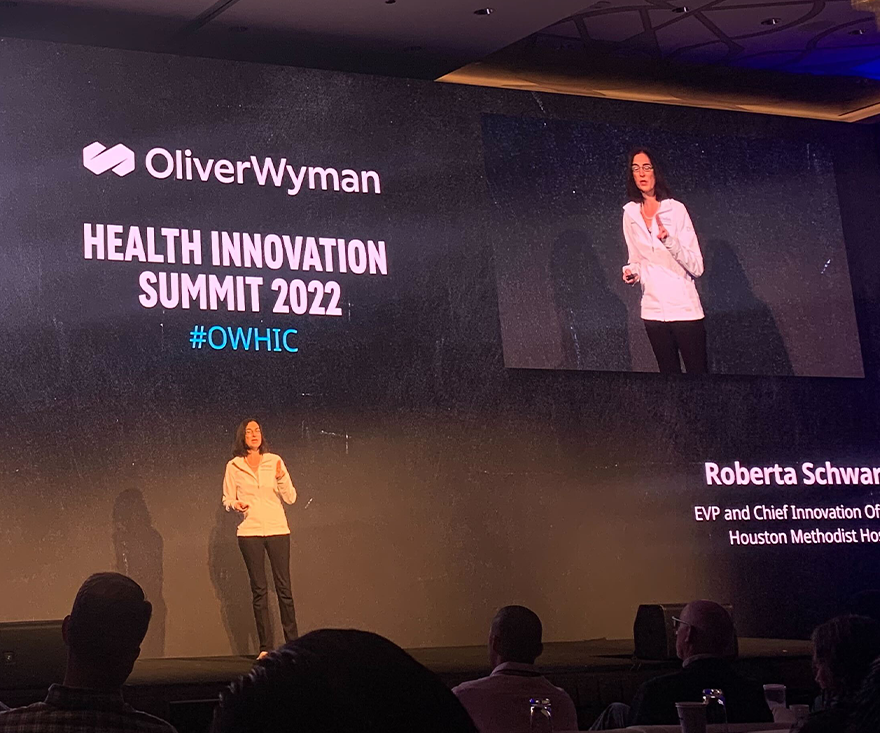Consumers seeking more tailored solutions. A drastically different competitive landscape. Unprecedented workforce challenges. Unpredictable economic times.
These are just a few of the headwinds barreling down on the healthcare industry. If leaders don’t respond quickly, they risk becoming irrelevant.
“We can solve this,” Minoo Javanmardian, Partner, Oliver Wyman, said during her opening Center Stage remarks on the final day of the Oliver Wyman Health Innovation Summit. “The winners will be the ones using this crisis to transform and reinvent healthcare.”
To be sure, incumbents face some obstacles on the way to reinvention. As Javanmardian detailed, many new competitors — digital startups, Amazon, Walmart, and others — are not incumbered by the same regulatory and fixed labor costs as health systems. As a result, they can start at a more favorable cost position. But that doesn’t mean incumbents should sit on their hands. Instead, they must take advantage of the same tools being used by new entrants. For instance, they can use artificial intelligence and machine learning to help identify and remove waste in their operations. There should be greater standardization across the sector to create efficiencies. And, critically, they can change the value proposition for the workforce through redesigned staffing models, more attention to employee wellbeing, and smarter use of technology.
That latter point is front and center for Roberta Schwartz, Executive Vice President and Chief Innovation Officer, Houston Methodist. Schwartz delivered a detail-rich presentation on how creative use of technology is helping Houston Methodist build a sustainable workforce.
The first step, she said, was throwing away the regular playbook of retention bonuses and breaking the bank on travel nurses. “Innovation is the only way out,” she said.
Some examples: deploying a telenursing platform that relies on a centralized team of nurses linked to iPads in patient rooms to conduct intake and patient discharge. The program cut 30 minutes out of the time it takes to do those processes and freed bedside nurses to get back to patient care.
They are also using the BioButton to track patient vitals in real-time, eliminating the need for nurses to continually wake patients up at night. And chatbots and natural language processing were deployed during COVID-19 vaccination events to automate and streamline scheduling. That effort has been expanded to other areas.
Culture change is the biggest hurdle, she said, to embracing this approach. “You need a stomach of steel and absolute dedication to say you are not always going to get it right,” she said, but it is working so far for the system’s flagship hospital which Schwartz runs. “I have a net positive margin this year.”
Smarter Decisions
Further proving that incumbents can spur change was Ricardo Johnson, Executive Vice President for Enterprise Strategy and Emerging Businesses, CareFirst BlueCross BlueShield, and head of Heathworx, the insurer’s innovation and investment arm.
Spotlighting a seemingly mundane change, Johnson shared how technology from Zipari, a company that Heathworx funded, streamlined processes and improved member experience. Prior to implementing the solution, CareFirst operated five claims systems. If a member changed jobs or switched from an employer-sponsored plan to an individual plan, their data would get lost in the system and customer service representatives wouldn’t have a total view of the member’s history. The Zipari solution fixed that problem. Now, no matter which CareFirst plan a member switches to, their history follows.
Believing that the insurer was well positioned to provide longitudinal care, it launched a virtual first primary care company last year called CloseKnit, which already has 30,000 members, Johnson said. The company is tapping into data analytics to drive care decisions (you can read more about how Johnson thinks about innovation in this Oliver Wyman Health interview from last year).
Data is what’s also behind Lisa Alderson’s push to scale the use of genomics in care delivery. The Co-founder and CEO of Genome Medical, Alderson is a passionate advocate for how genomics can improve patient care at all stages of life and across the care continuum. She articulated both a clinical and business case for genomics, for instance, noting that 80% of people have gene to drug factors that would inform treatment choices or drug dosing. And, she said, savings for the cost of care for high-risk patients can be as high as 75%.
“We have the science. We have the technology. We need to bring this into the hands of clinicians and patients,” she said.
Health Plans: Good or Bad?
Closing out the Summit, Snezana Mahon, Chief Operating Officer, Transcarent; and Brigitte Nettesheim, President, Enterprise and National Accounts, Aetna, engaged in an Oxford-style debate on the topic of whether health plans are part of the problem or part of the solution.
At the outset, audience members were asked to vote if they thought health plans can and should be part of the effort to deliver high-quality, low-cost care. An unofficial count suggested that the room was evenly split. It was up to Mahon and Nettesheim to change people’s minds.
Nettesheim drove home the point that health plans are evolving into health solution companies, especially with major acquisitions of physician groups and other providers. She said the plans are not afraid of innovating, either on their own or with external partners. And they have the scale to bring those innovations to the masses.
For her part, Mahon zeroed in on the fact that plans continue to rack up historic profits while outcomes in the US lag all other high-income countries. There are misaligned incentives between payers, providers, and employers, she said, adding that for consumers, navigating the system is unnecessarily cumbersome.
They did, however, agree that greater transparency is required and that the federal government can pull some appropriate levers to force change. When all was said and done, the audience remained evenly divided, with a handful of people switching sides.


